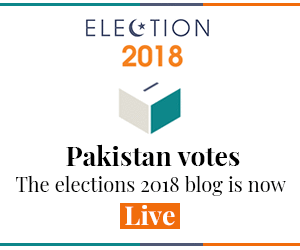Economic visions
ALL the three major political parties — the PML-N, PTI and the PPP — included substantial discussions on the economy in their 2013 manifestos.
The PPP preferred to focus on redistributive policies, or what it calls “equitable and inclusive growth”.
Where it did talk about growth, its focus was on small and medium enterprises, jobs, skills and agriculture.
Its focus on manufacturing was in the form of Special Economic Zones, or zones carved out of the national economy where a different set of policies would be applicable to encourage investment.
On trade, it said only that it would “build on creative currency swap agreements”.
The PML-N focused on macroeconomic indicators.
It pledged to cut the budget deficit and inflation, open markets for trade and raise the tax-to-GDP ratio to 15pc by the end of its term.
For industry, the party offered a set of incentives to boost exports and foreign investment, and pledged to broaden the export base beyond textiles to include IT products.
The PTI’s manifesto highlighted stagnant growth rates in 2013, build-up of national debt, depleting foreign exchange reserves and the high fiscal deficit.
It also targeted a 6pc growth rate and pledged to reduce inflation (below 7pc) and raise investment to 21.4pc of GDP from 12pc in 2013.
Tax revenue, the manifesto promised, would rise to 15pc of GDP — the same commitment as the PML-N — while “welfare spending” would quadruple, and the fiscal deficit narrowed to 4.5pc of GDP.
The PML-N and PTI, despite the hostile politics between them, offered substantially similar economic visions in 2013 but different paths to achieving them.
Where the PML-N talked of incentives, the PTI pinned its delivery on tackling corruption, taking action against cartels, hoarders, speculators and power and fuel theft.
In short, where the vision presented by the PML-N aimed to provide incentives to promote growth and exports, the PTI’s goal was to weed out behaviour and practices it felt were holding back the country’s economic potential.
Beyond that, they converged on the same objectives.
Perhaps for this election, the parties can sharpen their focus on three specific, core dysfunctions that afflict Pakistan’s economy.
These are the circular debt, the fiscal deficit and the external sector deficit (or the erosion of the economy’s competitiveness versus other countries).
These dysfunctions lie at the heart of what ails the economy, and nothing can change until they are tackled in a sustainable way.
By now, all parties should have learnt that what was described as the ‘energy crisis’ in 2013 was far more than just a gap between the supply and demand for electricity.
It was also an inability to meet the power sector’s growing costs, its upfront investment costs as well as its running costs.
Moreover, it was also the inability to grow and manage the power sector within the confines of a centralised power bureaucracy.
This is why all the megawatts on earth will not save us from what we call the ‘power crisis’ if deep-rooted reforms are not advanced in tandem.
The twin deficits — fiscal and external — are linked, and they have for decades sent our rulers on a search for big partners who were willing to subsidise our dysfunctions in return for a commitment to help advance their agenda in our own region.
This has worked to our detriment.
Outside of geopolitics, there is the International Monetary Fund.
This tendency of the economy to burn foreign exchange reserves within a few years, thereby forcing an approach to the IMF, has to end, and the only way it can is if we have a vision that targets the root cause — the economy.
For example, consider that all research on the question is now clear that a more open regional trade policy can play a vital role in improving the economy’s capacity to accumulate foreign exchange reserves, yet powerful impediments remain in moving ahead in this direction.
When drawing up their manifestos, the parties should use the opportunity to reflect on how these three problems are interlinked, then make them the centrepiece of their electoral document.
Let each party promise to take the country out of the decades-old cycle of continuous depletion of foreign exchange reserves and reform the power system to make it able to sustain its own costs.
That is an ambition worthy of a five-year effort at the top.
Published in Dawn, June 6th, 2018





